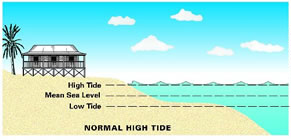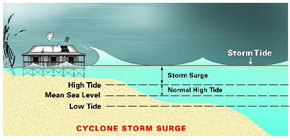Storm surge
This page will help you prepare if a storm surge is forecast in your area of the Northern Territory.
About storm surges
When a tropical cyclone moves near the coast, it can cause sea levels to rise as a storm surge above normal tides.
The storm surge may peak before the cyclone crosses the coastline.
Breaking waves at the top of the surge act like a giant bulldozer, sweeping everything in its path.
The worst impacts occur when a storm surge arrives on top of a high tide.
The technical name for a normal tide combined with a storm surge is a storm tide.


(Image courtesy of the Bureau of Meteorology)
Living in a low-lying coastal area
If you live in a low-lying coastal area at risk of storm surge, you should:
- check the storm surge area maps to see if you are in a storm surge zone
- know that your property may be subject to flooding and waves caused by a storm surge
- be prepared to evacuate to higher ground at short notice
- stay inside and shelter away from windows during a storm
- monitor radio and television messages from authorities if a storm surge is expected
- keep a list of emergency numbers handy
- prepare and keep your emergency kit close to you.
Water and sewerage
Heavy rain and flooding can impact your water supply or sewer system.
Find out more about the water and sewerage problems you could face at the Power and Water website.
Checklist for evacuating storm surge area
If you find out your home could be affected by a storm surge, you should take the following steps.
Step 1. Get your emergency kit and keep it with you.
Step 2. Decide where you will shelter - with friends, relatives or in an emergency shelter.
Step 3. Aim for higher ground when you are planning a place to shelter and how to get there.
Step 4. If you have your own transport, make sure it has fuel and is ready.
Step 5. Listen to and follow the advice of authorities, including police and emergency services.
Storm surge areas
Storm surge maps are available via the Department of Environment and Natural Resources.
You may need to get planning consent to develop in a storm surge area. Read about cyclone, storm surge and riverine flooding building standards at the Northern Territory Government website.